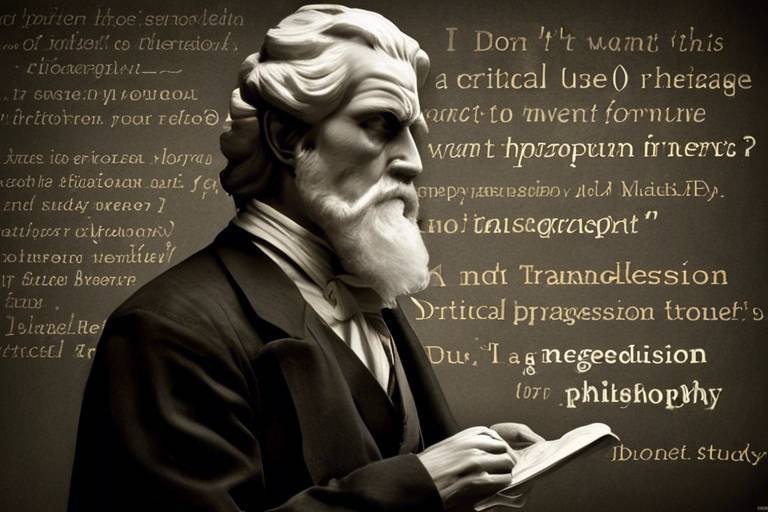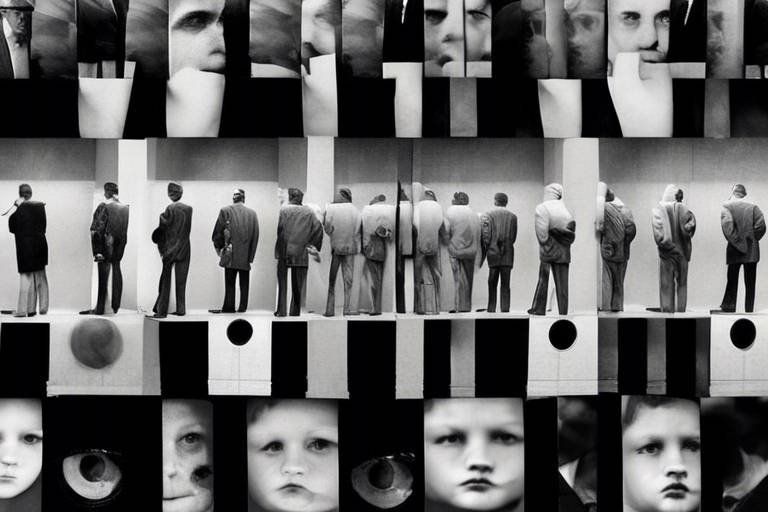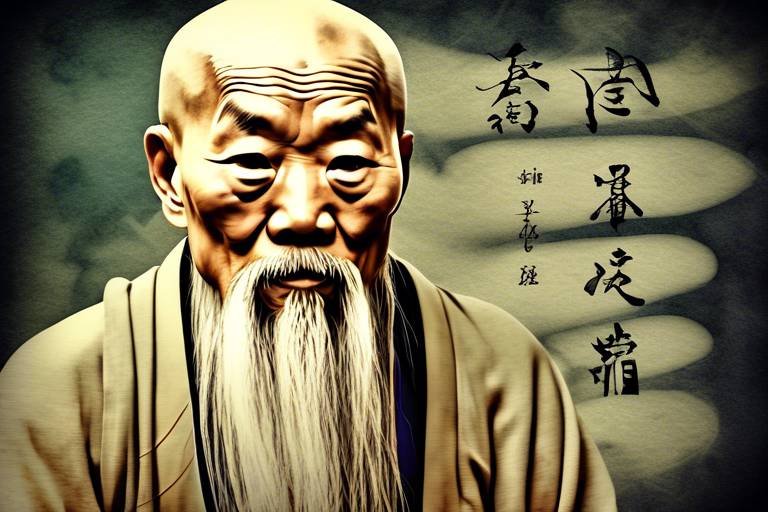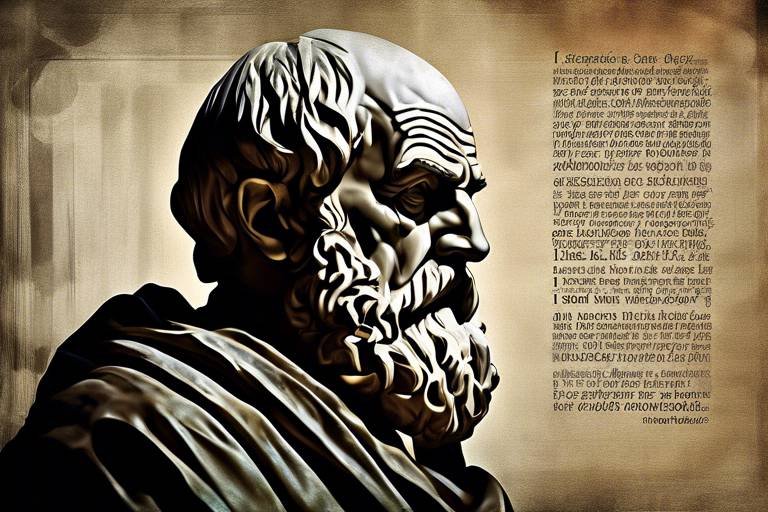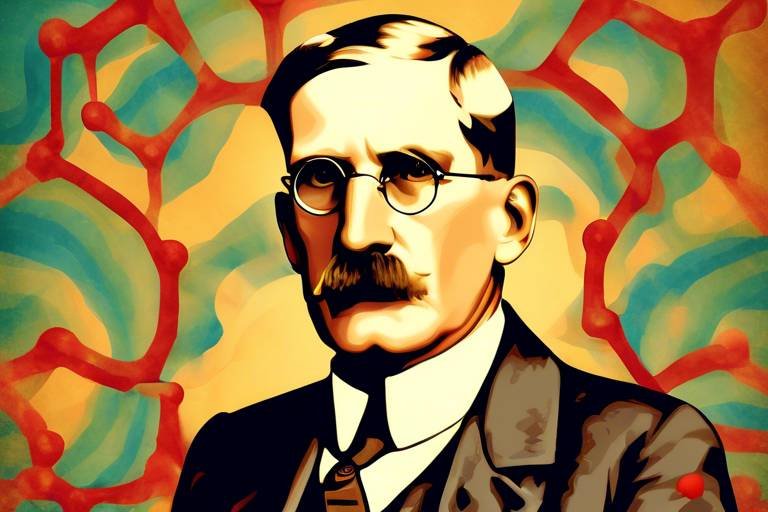Transgression in Philosophy - A Critical Study
The concept of transgression in philosophy is not merely about crossing boundaries; it is a profound examination of what those boundaries mean and how they shape our understanding of morality, ethics, and societal norms. At its core, transgression challenges the status quo, pushing against the limits of accepted thought and behavior. This exploration is not just an academic exercise; it resonates deeply with our everyday lives, influencing how we perceive right and wrong, acceptable and unacceptable. Through this critical study, we will delve into the implications of transgression, its historical evolution, and the ethical dilemmas it presents.
Throughout history, transgression has served as a catalyst for change, often igniting debates that question the very fabric of our moral landscape. Philosophers have grappled with the idea that breaking rules can sometimes lead to greater insights or progress. Imagine a world where every norm is unchallenged; it would be stagnant, devoid of growth or evolution. Transgression, therefore, is not just a rebellious act; it is a necessary force that propels us towards enlightenment and understanding.
In this article, we will explore various dimensions of transgression. We will begin by examining its philosophical underpinnings, tracing its historical roots from ancient thinkers like Plato and Aristotle to contemporary existentialists and postmodernists. Each of these figures has contributed to the evolving understanding of transgression, framing it within their unique contexts and cultural landscapes.
Furthermore, we will discuss the ethical implications of transgression, particularly how it provokes moral dilemmas and shapes individual and collective behavior. Can breaking societal norms lead to deeper ethical understanding, or does it risk chaos? This question is not easily answered, and our exploration will reflect the complexity of these discussions.
Additionally, we will investigate how transgression manifests in art and literature, serving as a powerful medium for challenging societal norms and provoking thought. Literary works often embody transgressive themes, using narrative to critique the very foundations of societal beliefs. Similarly, contemporary artists push boundaries, encouraging viewers to reflect on ethics and morality in new and provocative ways.
As we embark on this journey through the landscape of transgression in philosophy, we invite you to consider your own perceptions of boundaries and norms. Are there areas in your life where you feel constrained by societal expectations? What happens when we dare to step beyond those limits? Join us as we uncover the rich tapestry of transgression and its vital role in philosophical discourse.
- What is transgression in philosophy? - Transgression in philosophy refers to the act of violating established norms, rules, or boundaries, often leading to deeper insights into morality and ethics.
- How has the concept of transgression evolved? - The concept has evolved from ancient philosophies, such as those of Plato and Aristotle, to modern existential and postmodern thought, reflecting changing societal values.
- What are the ethical implications of transgression? - Transgression can provoke moral dilemmas and influence individual and collective behavior, raising questions about the nature of right and wrong.
- How does transgression appear in art and literature? - In art and literature, transgression challenges societal norms, encouraging critical thought and reflection on ethics and morality.

The Concept of Transgression
Transgression, in philosophical terms, refers to the act of going beyond established boundaries, norms, or rules. It is not merely about breaking laws or societal expectations; rather, it embodies a deeper challenge to the very foundations of thought and ethics. When we think about transgression, we often visualize a rebellious act, but it is much more than that. It is a provocative exploration of what it means to be human, to question the status quo, and to seek a broader understanding of morality.
Throughout history, transgression has played a significant role in shaping moral and ethical discussions. By daring to challenge the conventional, thinkers and artists alike have paved the way for new ideas and perspectives. This concept invites us to reflect on the limitations of our beliefs and encourages us to embrace the discomfort that comes with questioning what we know. It is in this space of uncertainty that we often find the most profound insights about ourselves and the world around us.
The significance of transgression can be categorized into several key aspects:
- Challenge to Norms: Transgression forces us to evaluate the norms we live by. Are they truly just, or are they merely inherited conventions?
- Ethical Reflection: By crossing boundaries, we are often confronted with ethical dilemmas that demand critical thinking and moral reasoning.
- Personal Growth: Engaging in transgressive acts can lead to personal enlightenment, as individuals confront their biases and expand their horizons.
One might ask, why is transgression necessary? The answer lies in its potential to foster innovation and progress. Think about the great revolutions in thought and art. Each one was sparked by individuals who dared to transgress the limits of their time. Whether it's questioning the divine right of kings or challenging the traditional roles of gender, transgression has been a catalyst for societal evolution. It pushes us to reconsider our beliefs and to engage in dialogue about what is right and wrong.
In essence, transgression is a double-edged sword. While it can lead to chaos and moral ambiguity, it also opens the door to new possibilities and deeper understanding. The beauty of transgression lies in its ability to provoke thought and inspire action, ultimately leading to a richer, more nuanced view of ethics and morality. As we navigate through life, embracing transgression can help us to not only understand the world better but also to redefine our place within it.

Historical Perspectives
The concept of transgression has undergone a fascinating evolution throughout the history of philosophy, acting as a mirror reflecting the changing values and beliefs of society. From its ancient roots to contemporary interpretations, transgression challenges the status quo, urging individuals and communities to reconsider established norms. This journey through time reveals how various thinkers have approached the notion of transgression, ultimately reshaping our understanding of ethics and morality.
In ancient philosophy, transgression was often viewed through the lens of morality and virtue. Philosophers like Plato and Aristotle laid crucial groundwork for the discussions that would follow. Their ideas not only influenced their contemporaries but also set the stage for future ethical considerations. Transgression, in this context, was not merely about breaking rules; it was about the pursuit of knowledge and the essence of being human.
Plato’s work, particularly his famous Allegory of the Cave, serves as a prime example of how ancient thought grappled with the concept of transgression. In this allegory, Plato depicts prisoners shackled in a cave, perceiving shadows cast on the wall as their only reality. The journey of one prisoner who escapes symbolizes the transgressive act of seeking truth beyond mere appearances. This allegorical journey from darkness to light represents the struggle against ignorance and the courage to challenge established beliefs.
Aristotle, on the other hand, approached transgression through the lens of virtue ethics. He believed that moral character is crucial in determining the rightness or wrongness of actions. According to Aristotle, transgression occurs when individuals stray from the Golden Mean, the desirable middle between excess and deficiency. For instance, courage is a virtue that lies between recklessness (excess) and cowardice (deficiency). This perspective emphasizes that transgression can be contextual, depending on the balance of virtues in an individual’s life.
As we move into modern philosophy, the interpretation of transgression shifts significantly, particularly with the emergence of existentialism and postmodernism. Thinkers such as Friedrich Nietzsche and Michel Foucault challenge traditional moral frameworks, arguing that societal norms are often constructs that can be deconstructed. Nietzsche, for instance, advocates for the idea of the "Übermensch," a figure who transcends conventional morality to create their own values. This perspective posits that transgression can lead to personal growth and societal evolution.
Foucault's analysis of power dynamics further complicates the understanding of transgression. He suggests that power is not merely repressive but also productive, shaping our perceptions of what is normal and acceptable. In this light, transgression becomes a means of resistance against oppressive structures, allowing individuals to redefine boundaries and challenge the status quo.
In summary, the historical perspectives on transgression reveal a rich tapestry of thought that has evolved over centuries. From the allegorical journeys of ancient philosophers to the radical redefinitions in modern philosophy, transgression continues to provoke critical thought and ethical inquiry. It invites us to question not only the boundaries of our beliefs but also the very foundations of our moral frameworks.
- What is transgression in philosophy? Transgression in philosophy refers to the act of violating established norms, beliefs, or ethical standards, often leading to a deeper understanding of morality and human nature.
- How has the concept of transgression evolved over time? The concept has evolved from ancient philosophical discussions about virtue and morality to modern interpretations that challenge societal norms and power structures.
- Who are some key figures associated with transgression? Key figures include Plato, Aristotle, Friedrich Nietzsche, and Michel Foucault, each contributing unique perspectives on the implications of transgression.

Transgression in Ancient Philosophy
The concept of transgression has deep roots in ancient philosophy, where it served as a pivotal point for exploring ethical and moral boundaries. Philosophers like Plato and Aristotle laid the groundwork for understanding how crossing established norms could lead to profound insights about human nature and society. Their ideas were not just academic musings; they were reflections of the human condition, grappling with the tension between societal expectations and personal enlightenment.
Plato, through his allegorical narratives, particularly in the famous Allegory of the Cave, illustrated transgression as a necessary journey from darkness to light. In this allegory, prisoners are confined in a cave, only able to see shadows projected on a wall, which they take for reality. The journey of one prisoner who escapes the cave symbolizes the transgressive act of seeking knowledge beyond accepted beliefs. This act of leaving the cave is not merely a physical escape; it represents the struggle against ignorance and the challenge of confronting uncomfortable truths. By stepping outside the cave, the individual not only defies the status quo but also embarks on a transformative quest for understanding, which can be seen as a form of intellectual transgression.
Aristotle, on the other hand, approached transgression from a different angle, focusing on the concept of virtue ethics. In his ethical framework, Aristotle emphasized the importance of balance and moderation, famously advocating for the "Golden Mean." He argued that moral character is developed through the practice of virtues, which lie between extremes of excess and deficiency. In this context, transgression can be viewed as the act of deviating from the mean, either by indulging too much or not enough. While Aristotle acknowledged that transgressing these boundaries could lead to vice, he also recognized that such actions could spark self-reflection and growth. This duality highlights the complex relationship between transgression and moral development, suggesting that crossing boundaries might sometimes be necessary for achieving greater ethical understanding.
In summary, ancient philosophers like Plato and Aristotle did not merely define transgression; they explored its implications for personal and societal growth. Their teachings reveal that while transgression can lead to moral dilemmas, it also opens doors to enlightenment and deeper ethical comprehension. This interplay between crossing boundaries and seeking truth remains a relevant discourse in contemporary philosophy, urging us to question the norms we often take for granted.
- What is transgression in philosophy? Transgression in philosophy refers to the act of crossing established moral or ethical boundaries, often leading to deeper understanding or enlightenment.
- How did ancient philosophers view transgression? Ancient philosophers like Plato and Aristotle viewed transgression as a complex concept that could lead to both moral dilemmas and personal growth.
- Why is the Allegory of the Cave significant? The Allegory of the Cave illustrates the journey from ignorance to knowledge, emphasizing the importance of questioning societal norms and seeking truth.
- What role does virtue ethics play in understanding transgression? Virtue ethics, as proposed by Aristotle, suggests that transgressing boundaries can lead to self-reflection and moral development, highlighting the importance of balance in ethical behavior.

Plato's Allegory of the Cave
Plato's Allegory of the Cave is one of the most profound and thought-provoking metaphors in Western philosophy. It serves as a powerful illustration of the concept of transgression, depicting the journey from ignorance to enlightenment. Imagine being confined in a dark cave your entire life, only able to see shadows cast on the wall by objects passing in front of a fire behind you. These shadows represent the limited understanding of reality that most people experience. Plato uses this allegory to challenge the established norms of perception and knowledge, suggesting that what we often accept as truth is merely a reflection of a deeper reality.
In this allegory, the cave symbolizes the world of appearances, where individuals are trapped in their own limited perspectives. The transgression occurs when one of the prisoners breaks free from the chains that bind them, embarking on a journey towards the light of the outside world. This journey is not just a physical escape; it represents a profound intellectual and spiritual awakening. As the freed prisoner ascends to the surface, they initially struggle to adjust to the brightness of the sun, which symbolizes the ultimate truth and knowledge. This discomfort reflects the challenges faced when one challenges established beliefs and norms.
Plato's allegory prompts us to consider several critical questions about knowledge and reality:
- What does it mean to know something?
- How do societal norms shape our understanding of truth?
- Is it possible to transcend our limited perspectives?
The implications of this allegory extend beyond philosophy; they resonate deeply in various aspects of life, including art, politics, and ethics. For instance, when artists create works that challenge societal norms, they often aim to awaken the audience from their metaphorical caves, urging them to confront uncomfortable truths. Similarly, political movements that seek to disrupt the status quo can be seen as a form of transgression, pushing society toward greater awareness and understanding.
Ultimately, Plato's Allegory of the Cave serves as a reminder that transgression is not merely about breaking rules; it is about seeking deeper truths and challenging the boundaries of our understanding. By encouraging individuals to step out of their comfort zones and question their perceptions, this allegory fosters a culture of critical thinking and philosophical inquiry, paving the way for personal and societal transformation.
- What is the main message of Plato's Allegory of the Cave? The main message is that reality is often obscured by our limited perceptions, and true knowledge requires a journey beyond the shadows of ignorance.
- How does the allegory relate to the concept of transgression? The allegory illustrates transgression as the act of breaking free from societal norms and established beliefs to seek deeper truths.
- Can the allegory be applied to modern society? Yes, it is relevant today as it encourages individuals to challenge conventional wisdom and strive for greater understanding in various fields, including art, politics, and ethics.

Aristotle's Ethics
Aristotle's approach to ethics is deeply rooted in the concept of virtue, which he defines as a trait of character manifested in habitual action. For Aristotle, the essence of a good life is not merely about following rules or avoiding wrongdoing; rather, it is about cultivating virtues that enable individuals to achieve eudaimonia, often translated as "flourishing" or "the good life." He believed that transgression, in the context of ethics, occurs when individuals stray from the mean, which is the desirable middle ground between two extremes of excess and deficiency.
In Aristotle's view, every virtue is located between two vices: one of excess and one of deficiency. For example, courage is the mean between recklessness (excess) and cowardice (deficiency). This framework emphasizes that ethical behavior is not a one-size-fits-all approach; instead, it requires a nuanced understanding of circumstances and a commitment to personal growth. Aristotle posits that to act virtuously, one must develop a deep understanding of oneself and the world, which often involves facing the uncomfortable truths that challenge societal norms.
Furthermore, Aristotle introduces the idea of phronesis, or practical wisdom, as a critical component of ethical decision-making. Phronesis allows individuals to navigate complex moral landscapes and make choices that reflect both their virtues and the realities of their situations. This concept highlights the importance of experience and context in ethical deliberation, suggesting that transgressing established norms can sometimes lead to greater moral clarity and understanding.
To illustrate Aristotle's ethical framework, consider the following table that summarizes the relationship between virtues and their corresponding vices:
| Virtue | Excess | Deficiency |
|---|---|---|
| Courage | Recklessness | Cowardice |
| Generosity | Profligacy | Stinginess |
| Temperance | Intemperance | Insensibility |
| Wisdom | Overthinking | Foolishness |
This table illustrates how Aristotle's ethical system is inherently tied to the idea of balance and moderation. Transgressing the boundaries of virtue can lead to moral chaos, but it can also be an opportunity for growth and deeper understanding. By recognizing the complexities of ethical behavior, we can appreciate the profound insights Aristotle provides regarding the nature of transgression and its implications for individual character and societal norms.
In conclusion, Aristotle's ethics invites us to reflect on our own lives and the choices we make. It challenges us to consider how our actions align with our virtues and whether we are truly living in accordance with our best selves. This perspective not only enriches our understanding of transgression but also encourages us to embrace the journey toward ethical living with openness and courage.
- What is Aristotle's concept of virtue?
Aristotle defines virtue as a trait of character that leads to good habits and moral excellence, situated between two extremes of excess and deficiency. - How does Aristotle's ethics relate to transgression?
Aristotle's ethics emphasizes the importance of finding balance; transgressing norms can lead to either moral chaos or greater understanding, depending on the context. - What is phronesis in Aristotle's ethics?
Phronesis, or practical wisdom, is the ability to make sound judgments in ethical situations, considering both virtues and the specific circumstances at hand.

Modern Interpretations
In the landscape of contemporary philosophy, the concept of transgression takes on new dimensions, often intertwining with movements like existentialism and postmodernism. These philosophical frameworks challenge established norms and invite us to rethink our understanding of morality and ethics. Existentialists, for instance, emphasize the individual's freedom and responsibility, suggesting that transgression can be a vital part of authentic existence. They argue that stepping outside societal boundaries is not merely an act of rebellion but a necessary journey toward self-discovery and personal truth.
On the other hand, postmodern thinkers often critique the very foundations of traditional moral frameworks. They contend that what we consider 'norms' are merely constructs shaped by historical and cultural contexts. This perspective raises a provocative question: if norms are fluid, does transgression still hold the same weight? In this light, transgression becomes a tool for deconstructing accepted truths, allowing individuals to navigate a complex moral landscape.
Furthermore, modern interpretations of transgression often highlight its role in social movements. Activists and thinkers alike have used the act of transgression as a means of challenging oppressive systems, arguing that breaking the rules can lead to significant social change. For example, movements advocating for civil rights, gender equality, and environmental justice have often employed transgressive tactics to draw attention to injustices and provoke critical conversations.
To illustrate these ideas, consider the following table that summarizes key modern philosophical perspectives on transgression:
| Philosophical Movement | Key Ideas on Transgression |
|---|---|
| Existentialism | Transgression as a path to authenticity and self-discovery. |
| Postmodernism | Transgression as a critique of normative constructs and societal boundaries. |
| Social Movements | Transgression as a catalyst for social change and justice. |
In conclusion, modern interpretations of transgression not only challenge the status quo but also encourage a deeper understanding of our moral choices. Whether through existential exploration or postmodern critique, the act of transgressing societal norms invites us to reflect on our values and the implications of our actions. As we navigate this intricate web of thought, one thing becomes clear: transgression is not just about breaking rules; it’s about redefining what it means to be human in a rapidly changing world.
- What is transgression in philosophy? Transgression in philosophy refers to the act of violating established norms or boundaries, often leading to new insights or ethical dilemmas.
- How has the concept of transgression evolved? The concept has evolved from ancient philosophical discussions to contemporary debates, reflecting changes in societal norms and moral frameworks.
- What role does transgression play in social movements? Transgression can serve as a powerful tool for social change, challenging injustices and prompting critical dialogue within society.
- Can transgression lead to positive outcomes? Yes, while it may provoke chaos, transgression can also foster greater ethical understanding and inspire societal progress.

Ethical Implications
The concept of transgression is not merely an academic exercise; it has profound that resonate deeply within our social fabric. At its core, transgression challenges the established norms and values that govern our lives. When individuals or groups step beyond the accepted boundaries of behavior, they often provoke a moral reckoning that can lead to both positive and negative outcomes. This duality raises critical questions: Does breaking the rules lead to greater ethical understanding, or does it spiral into chaos? The answers to these questions are not straightforward, and they often depend on the context in which transgression occurs.
Transgression can serve as a catalyst for change. For instance, historical movements that have challenged societal norms—such as the civil rights movement or the feminist movement—often involved acts of transgression that pushed back against deeply ingrained prejudices and injustices. These acts, while seen as defiant at the time, ultimately led to a broader understanding of equality and human rights. In this sense, transgression can illuminate moral truths that were previously obscured by convention.
However, the ethical implications of transgression are not always positive. When individuals disregard societal norms without a compelling purpose, they risk descending into moral ambiguity. The line between justified rebellion and reckless disregard for the law can often blur. For example, consider the difference between civil disobedience, which is often viewed as a noble act of conscience, and criminal behavior, which is typically condemned. This distinction raises the question: What criteria should we use to evaluate the morality of transgressive acts?
To better understand the ethical implications of transgression, we can explore several key dimensions:
- Moral Dilemmas: Transgression often presents individuals with moral dilemmas, forcing them to weigh the value of their actions against the potential harm they may cause.
- Collective Behavior: The impact of transgressive actions can ripple through society, influencing collective behavior and potentially leading to shifts in cultural norms.
- Personal Responsibility: Individuals who engage in transgressive acts must grapple with their personal responsibility and the consequences that arise from their choices.
Ultimately, the ethical implications of transgression challenge us to rethink our understanding of morality itself. They compel us to ask whether our moral frameworks are rigid enough to accommodate the complexities of human experience. As we navigate the murky waters of ethical decision-making, we must consider both the risks and rewards that come with stepping beyond the boundaries of accepted behavior.
As we reflect on these ethical dimensions, it becomes clear that transgression is not simply about breaking the rules; it’s about engaging in a deeper dialogue about what it means to be ethical in a rapidly changing world. The conversations sparked by transgressive acts can lead to a richer understanding of our values and the principles that guide our lives.
- What is transgression in philosophy?
Transgression in philosophy refers to the act of breaking or exceeding established norms, which challenges traditional ethical boundaries and prompts critical discussions about morality. - Can transgression lead to positive change?
Yes, transgression can serve as a catalyst for positive change by challenging unjust norms and inspiring social movements that promote equality and justice. - What are some examples of transgression in society?
Examples include civil disobedience during the civil rights movement, protests against governmental policies, and artistic expressions that challenge societal expectations. - How do we evaluate the morality of transgressive acts?
Evaluating the morality of transgressive acts involves considering the intent behind the action, the context in which it occurs, and the potential consequences for individuals and society.

Transgression and Morality
The relationship between transgression and morality is a complex and often contentious issue in philosophical discourse. At its core, transgression involves breaking or challenging established norms and rules, which raises the question: can violating these norms lead to a deeper understanding of ethics, or does it simply plunge society into chaos? This debate has been a focal point for philosophers throughout history, as they grapple with the implications of moral boundaries and the potential for growth that lies beyond them.
Consider the idea that transgression can serve as a catalyst for moral evolution. Just as a seed must break through the soil to grow into a robust plant, individuals and societies often need to challenge the status quo to foster progress. This perspective suggests that transgressing moral boundaries may lead to greater ethical understanding. Think of the civil rights movement; activists like Martin Luther King Jr. and Rosa Parks engaged in acts of transgression against unjust laws, ultimately leading to significant societal change. Their actions invite us to ponder whether the ends justify the means when it comes to moral transgression.
However, the flip side of this argument cannot be ignored. Some philosophers warn of the potential dangers that come with unchecked transgression. When norms are disregarded without a thoughtful examination of their ethical basis, we risk descending into moral relativism. This is where the lines become blurred, and individuals may justify harmful actions under the guise of personal freedom or self-expression. The challenge lies in discerning when transgression is a necessary step towards enlightenment and when it becomes a path to moral decay.
To further understand this dynamic, we can explore several key questions:
- What constitutes a moral transgression, and who decides what is deemed transgressive?
- Can transgressing norms lead to a more profound ethical understanding, or does it merely create confusion?
- How do societal contexts influence our perception of transgression and morality?
In examining these questions, it becomes evident that context plays a critical role. For instance, in some cultures, actions considered transgressive in one society may be celebrated in another. This cultural relativism challenges the notion of universal moral principles and complicates the discourse surrounding transgression. As a result, the ethical implications of transgression are not only philosophical but also deeply rooted in social and cultural dynamics.
Ultimately, the interplay between transgression and morality is a dance of sorts—one that requires balance and reflection. While transgression can indeed lead to progress and transformation, it is essential to approach it with caution and a critical mindset. As we navigate this intricate landscape, we must ask ourselves: how do we define our moral boundaries, and what are we willing to challenge in the pursuit of a more just and equitable society?
- What is transgression in philosophy? Transgression in philosophy refers to the act of breaking or challenging established norms, rules, or moral boundaries, often leading to deeper ethical inquiries.
- How does transgression relate to morality? Transgression can provoke moral dilemmas, prompting discussions about whether breaking norms can result in greater ethical understanding or societal chaos.
- Can transgression be justified? The justification of transgression often depends on the context and the outcomes it produces, as well as the moral framework one adheres to.
- Are there examples of transgression leading to positive change? Yes, historical movements such as civil rights and social justice often involved acts of transgression that challenged unjust laws and norms, leading to significant societal improvements.

Case Studies in Transgression
Transgression isn't just a philosophical concept; it manifests vividly in our world through various case studies that challenge societal norms and provoke critical thought. From art to politics, transgression serves as a catalyst for change, often igniting conversations that would otherwise remain dormant. Let's delve into some compelling examples that illustrate how transgression operates in real life, revealing the intricate dance between ethics and societal expectations.
One of the most striking instances of transgression can be observed in the realm of art. Take, for example, the works of Marina Abramović, a performance artist known for pushing boundaries. In her infamous piece, "Rhythm 0," Abramović invited the audience to use various objects on her body, ranging from a rose to a loaded gun. This act of vulnerability and trust not only challenged the audience's moral compass but also forced them to confront their own potential for violence and cruelty. It raises the question: how far are we willing to go in the name of art, and what does that say about our ethical boundaries?
Similarly, in the political arena, figures like Edward Snowden exemplify transgression through their actions. By leaking classified information about government surveillance programs, Snowden's actions sparked a global debate on privacy, security, and the ethical implications of state power. While some view him as a hero, others see him as a traitor. This divergence in perspective highlights how transgression can lead to profound moral dilemmas, forcing society to reevaluate its values and principles.
In literature, we encounter transgression through the works of authors like James Baldwin and Margaret Atwood. Baldwin's essays on race and sexuality challenge societal norms and invite readers to consider the complexities of identity and belonging. Similarly, Atwood's "The Handmaid's Tale" serves as a cautionary tale about the consequences of extreme societal control and the erasure of individual rights. Both authors use their narratives to provoke thought and inspire action, illustrating how literature can serve as a powerful tool for social change.
Moreover, the transgressive movements within social activism, such as the Me Too movement, demonstrate how collective transgression can lead to significant societal shifts. By breaking the silence surrounding sexual harassment and assault, individuals have challenged the status quo, demanding accountability and justice. This movement not only highlights the power of personal narratives but also underscores the ethical implications of silence in the face of wrongdoing.
In conclusion, these case studies reveal that transgression is not merely an abstract idea; it is a dynamic force that shapes our understanding of morality and ethics. Whether through art, politics, literature, or social movements, transgression challenges us to confront uncomfortable truths and reconsider our values. It forces us to ask ourselves: are we willing to transgress in the pursuit of a more just and equitable society?
- What is transgression in philosophy? Transgression in philosophy refers to the act of violating established norms or boundaries, often leading to a deeper understanding of ethics and morality.
- How does transgression relate to art? Transgression in art challenges societal norms, provoking thought and dialogue about ethical issues and human behavior.
- Can transgression lead to positive change? Yes, transgression can catalyze societal change by confronting injustices and prompting critical discussions about moral values.
- Who are some key figures associated with transgression? Notable figures include philosophers like Foucault, artists like Marina Abramović, and activists like Edward Snowden.

Transgression in Art and Literature
Transgression in art and literature is a fascinating subject that dives deep into the heart of creativity and societal norms. It’s like a rebellious teenager challenging the rules set by their parents—art and literature often push boundaries, question authority, and provoke thought in ways that can be both exhilarating and unsettling. Think about it: when was the last time a piece of art or a novel made you stop and reconsider everything you thought you knew? That’s the power of transgression.
Throughout history, artists and writers have used their platforms to challenge societal expectations and provoke critical thought. This transgressive approach serves not only as a form of expression but also as a catalyst for change. For example, the works of authors like James Joyce and Virginia Woolf broke away from traditional narrative structures, inviting readers to experience literature in a radically new way. Their styles weren't just different for the sake of being different; they were deliberate acts of transgression against the conventional storytelling methods of their time.
In the realm of visual arts, artists like Marcel Duchamp and Banksy have made significant impacts by creating works that challenge societal norms and provoke dialogue. Duchamp’s “Fountain”, a simple urinal presented as art, questioned the very definition of art itself, while Banksy’s street art often critiques political and social issues, pushing viewers to confront uncomfortable truths. These artists don’t just create; they engage in a philosophical dialogue about what it means to transgress boundaries.
Moreover, transgression in art and literature often reflects the cultural and political climates of their times. For instance, during periods of oppression, artists may resort to transgressive themes as a form of resistance. Consider the Harlem Renaissance, where African American artists and writers used their work to challenge racial stereotypes and advocate for civil rights. This movement was not just about artistic expression; it was a profound act of transgression against a society steeped in racism and inequality.
In literature, transgressive themes can often lead to moral dilemmas, forcing readers to confront their own beliefs and values. For example, novels like “A Clockwork Orange” by Anthony Burgess explore the darker sides of human nature and the implications of free will versus societal control. Such works compel readers to grapple with uncomfortable questions about morality, ethics, and the consequences of transgression.
Transgression isn’t just about breaking rules; it’s about expanding the conversation. It invites us to think critically about our surroundings and the structures that govern our lives. Whether through the lens of literature or the canvas of art, transgressive works challenge us to reconsider the status quo and reflect on our own beliefs. They act as mirrors, reflecting society back at itself while simultaneously pushing us to envision a world beyond our current limitations.
In conclusion, the interplay of transgression in art and literature showcases a vibrant landscape of ideas and challenges. It’s a reminder that creativity is not just about aesthetics; it’s about dialogue, dissent, and the relentless pursuit of truth. As we continue to navigate a complex and often contradictory world, the transgressive nature of art and literature will remain a vital force, urging us to question, reflect, and ultimately grow.
- What is transgression in art and literature?
Transgression refers to the act of violating established norms and boundaries within artistic and literary expressions, often leading to critical thought and societal change. - Why is transgression important in creative works?
Transgression challenges the status quo, provokes dialogue, and encourages audiences to reflect on their beliefs and the world around them. - Can transgression lead to societal change?
Yes, many artists and writers have used transgressive themes to address social issues, influence public opinion, and inspire movements for change.

Literary Examples
Literature has long served as a powerful medium for exploring the concept of transgression. Through the written word, authors have the unique ability to challenge societal norms, provoke thought, and ignite discussions that might otherwise remain dormant. One of the most compelling aspects of transgressive literature is its ability to push boundaries, inviting readers to engage with themes that are often considered taboo or controversial. For instance, consider the works of authors like James Joyce and Virginia Woolf, who employed stream-of-consciousness techniques to delve deeply into the human psyche, often revealing the darker, more chaotic aspects of existence. Their narratives frequently blur the lines between morality and immorality, forcing readers to confront their own beliefs about right and wrong.
Another notable example is Franz Kafka, whose works often reflect the absurdity of the human condition. In "The Metamorphosis," Kafka presents a protagonist who undergoes a grotesque transformation, symbolizing the alienation and disconnection that can arise in modern society. This radical shift from human to insect serves as a profound commentary on the struggle against societal expectations and the inherent transgressions that come with it. Kafka's exploration of existential themes resonates with the idea that transgression is not merely an act of rebellion but a reflection of deeper philosophical inquiries.
Moreover, F. Scott Fitzgerald in "The Great Gatsby" illustrates the transgressive nature of the American Dream. Through the character of Jay Gatsby, Fitzgerald critiques the moral decay hidden beneath the glitzy surface of the Roaring Twenties. Gatsby's relentless pursuit of wealth and status leads him to transgress social boundaries, ultimately resulting in tragic consequences. This narrative serves as a poignant reminder of the ethical dilemmas that arise when ambition overshadows morality, inviting readers to reflect on their own values and aspirations.
In contemporary literature, authors like Chuck Palahniuk and Margaret Atwood continue to explore transgressive themes. Palahniuk's "Fight Club" challenges consumerist culture and societal expectations through its portrayal of an underground fight club that serves as a metaphor for rebellion against conformity. Atwood's "The Handmaid's Tale," on the other hand, presents a dystopian vision of a society where women's rights are stripped away, prompting readers to question the fragility of freedom and the consequences of societal transgressions.
These literary examples not only highlight the significance of transgression in understanding human behavior but also demonstrate how literature can serve as a mirror reflecting societal issues. By engaging with transgressive themes, readers are encouraged to confront uncomfortable truths and engage in critical dialogue about morality, ethics, and the boundaries of thought.
In conclusion, transgression in literature is not merely a narrative device; it is a vital philosophical exploration that challenges readers to reconsider their perceptions of right and wrong. As we delve into these literary works, we are reminded that the act of transgression can lead to profound insights and a deeper understanding of the human experience.
- What is transgression in literature? Transgression in literature refers to the act of challenging or violating societal norms, often exploring themes that provoke thought and discussion.
- Why is transgression important in philosophical discourse? Transgression is crucial in philosophy as it encourages critical examination of established beliefs and ethical frameworks, pushing the boundaries of thought.
- Can transgressive literature lead to societal change? Yes, transgressive literature can inspire readers to question societal norms and consider alternative perspectives, potentially leading to social change.

Artistic Expressions
Art has always been a powerful medium for expressing ideas that challenge societal norms and provoke critical thought. When we talk about transgression in art, we are delving into a realm where creativity meets rebellion. Artists often use their work as a canvas to question the status quo, pushing boundaries that society has carefully constructed over time. This transgressive nature of art not only highlights the artist's perspective but also invites the audience to engage in a dialogue about ethics, morality, and the very fabric of societal expectations.
Consider the works of contemporary artists like Marina Abramović, whose performances often blur the line between art and life, challenging viewers to confront uncomfortable truths about human nature and societal norms. In her piece "The Artist is Present", she sat silently across from participants, inviting them to share a moment of vulnerability. This act of transgression—stripping away the barriers between artist and audience—forces us to reflect on our own emotional states and the societal constructs that dictate our interactions.
Another notable example is the provocative street art of Banksy, whose works often carry strong political messages that challenge authority and consumerism. His art disrupts public spaces, turning everyday environments into arenas of critical thought. For instance, his piece "Girl with a Balloon" not only evokes emotion but also critiques the commodification of art itself. Such artistic expressions serve as a mirror to society, reflecting its flaws and encouraging viewers to question their own complicity in these systems.
Transgressive art can also be seen in literature, where authors utilize narrative to critique societal norms. For example, Chuck Palahniuk's "Fight Club" delves into themes of masculinity and consumer culture, challenging the reader to rethink their understanding of identity and societal expectations. Through the lens of a seemingly ordinary life, Palahniuk exposes the chaos lurking beneath the surface, prompting readers to confront uncomfortable truths about their own lives.
In essence, artistic expressions of transgression serve a dual purpose: they challenge viewers to reconsider their beliefs while simultaneously pushing the boundaries of what is considered acceptable in art. This dialogue between artist and audience is what makes transgressive art so vital. It creates a space for reflection and discussion, inviting us to explore the gray areas of morality and ethics. As we engage with these works, we are not merely spectators but active participants in a broader conversation about the world we inhabit.
- What is transgression in art? Transgression in art refers to the act of challenging societal norms and expectations through creative expression. Artists often use their work to provoke thought and discussion about ethical and moral issues.
- Why is transgressive art important? Transgressive art is important because it encourages critical thinking and dialogue about societal constructs, pushing viewers to confront uncomfortable truths and consider alternative perspectives.
- Can transgressive art have negative consequences? Yes, while transgressive art can provoke thought and discussion, it can also lead to controversy and backlash, especially if it challenges deeply held beliefs or societal norms.
Frequently Asked Questions
- What does transgression mean in philosophy?
Transgression in philosophy refers to the act of going beyond established boundaries, norms, or ethical standards. It challenges the status quo and provokes critical thinking about moral and ethical implications. Essentially, it’s about questioning what is accepted and exploring the consequences of breaking those accepted rules.
- How has the concept of transgression evolved over time?
The idea of transgression has deep historical roots, stretching back to ancient philosophers like Plato and Aristotle, who laid the groundwork for understanding moral boundaries. Over time, it has evolved through various philosophical movements, including existentialism and postmodernism, which further redefine and challenge traditional norms.
- What role does transgression play in ethics?
Transgression plays a crucial role in ethical discussions by provoking moral dilemmas and challenging individuals and societies to reconsider their values. It raises questions about whether breaking norms can lead to greater ethical understanding or if it results in chaos. This tension is at the heart of many philosophical debates.
- Can you provide examples of transgression in art and literature?
Absolutely! Many literary works and artistic expressions embody transgressive themes. For instance, authors like James Joyce and Virginia Woolf challenge societal norms through their narratives, while contemporary artists often use provocative imagery to spark dialogue about ethics and morality, pushing viewers to confront uncomfortable truths.
- How does Plato's Allegory of the Cave relate to transgression?
Plato's Allegory of the Cave illustrates transgression as a transformative journey from ignorance to enlightenment. It represents the struggle to break free from established beliefs and perceptions, encouraging individuals to question their reality and seek deeper truths beyond societal norms.
- What is the connection between transgression and modern philosophical thought?
Modern philosophical thought, particularly existentialism and postmodernism, reinterprets transgression by emphasizing individual experience and the fluidity of moral boundaries. These movements encourage questioning established norms and exploring personal truths, often celebrating the act of transgression as a means of self-discovery and societal critique.

